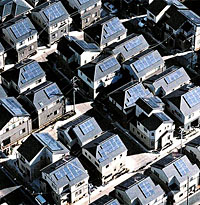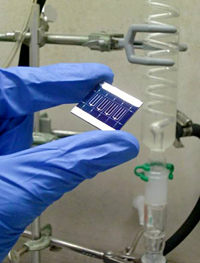The Future of Solar Energy: Innovations and Emerging Technologies
[ad] Empty ad slot (#1)!
Solar energy, harnessed from the abundant power of the sun, has seen tremendous growth and technological advancement over the past few decades. As the world grapples with the pressing issues of climate change and the depletion of fossil fuels, solar energy stands out as a sustainable and increasingly viable solution. This article explores the latest advancements in solar technology and what the future holds for solar energy.
Advances in Photovoltaic Technology
1. High-Efficiency Solar Cells:
One of the most significant advancements in solar technology is the development of high-efficiency solar cells. Traditional silicon-based solar cells have seen improvements in efficiency, reaching up to 22-24% in commercial products. However, new materials and technologies are pushing these boundaries further.
- Perovskite Solar Cells: Perovskite materials have emerged as a game-changer, achieving efficiencies over 25% in laboratory settings. These cells are cheaper to produce and can be manufactured using low-temperature processes, making them a promising candidate for future commercial applications.
- Tandem Solar Cells: Combining different photovoltaic materials in tandem solar cells can significantly increase efficiency. For instance, pairing perovskite cells with silicon cells has demonstrated efficiencies exceeding 29%.
2. Bifacial Solar Panels:
Bifacial solar panels can capture sunlight from both sides, enhancing energy generation by up to 30% compared to traditional monofacial panels. This technology leverages reflected light from surfaces such as the ground or water, making it particularly effective in diverse environments.
3. Transparent Solar Cells:
Transparent solar cells represent an innovative approach to integrating solar technology into windows and building facades. These cells can generate electricity while allowing light to pass through, potentially transforming urban architecture into a massive energy-harvesting network.
Energy Storage Solutions
The intermittent nature of solar energy has long been a challenge. However, advancements in energy storage are addressing this issue, making solar power more reliable.
1. Lithium-Ion Batteries:
Lithium-ion batteries remain the most widely used storage solution due to their high energy density and decreasing costs. Innovations in battery chemistry and manufacturing processes are improving their lifespan and efficiency, making them more suitable for large-scale solar energy storage.
2. Solid-State Batteries:
Solid-state batteries, which use a solid electrolyte instead of a liquid one, offer greater energy density, safety, and longevity compared to lithium-ion batteries. Although still in the developmental stage, these batteries hold promise for future solar energy systems.
3. Flow Batteries:
Flow batteries, such as vanadium redox flow batteries, are gaining attention for their scalability and long cycle life. These batteries store energy in liquid electrolytes contained in external tanks, allowing for easy scaling to meet large energy storage needs.
Solar Power Integration and Smart Grids
The integration of solar power into the existing grid infrastructure is crucial for maximizing its potential. Smart grid technologies are facilitating this integration through real-time monitoring, automated control, and enhanced grid stability.
1. Grid-Tied Solar Systems:
Grid-tied solar systems allow excess solar energy to be fed back into the grid, providing energy credits to the system owners. This not only reduces electricity bills but also supports grid stability by distributing renewable energy.
2. Microgrids and Decentralized Energy:
Microgrids, which are localized grids that can operate independently from the main grid, are becoming more prevalent. These systems enhance energy security and resilience, particularly in remote or disaster-prone areas. Decentralized energy generation from solar microgrids can reduce transmission losses and improve overall efficiency.
3. Artificial Intelligence and Predictive Maintenance:
Artificial intelligence (AI) is playing a crucial role in optimizing solar energy systems. AI algorithms can predict energy production based on weather forecasts, enabling better energy management. Additionally, predictive maintenance powered by AI can identify potential issues in solar installations before they lead to failures, reducing downtime and maintenance costs.
Emerging Technologies and Future Prospects
1. Solar Paint:
Researchers are developing solar paint, which contains light-sensitive materials capable of generating electricity. This paint can be applied to various surfaces, turning any structure into a potential solar energy generator.
2. Space-Based Solar Power:
The concept of space-based solar power involves capturing solar energy in space and transmitting it to Earth via microwave or laser beams. This technology could provide a continuous and inexhaustible energy supply, as space-based solar arrays can collect sunlight 24/7 without atmospheric interference.
3. Solar Fuels:
Solar fuels, produced by converting solar energy into chemical fuels like hydrogen, offer a way to store and transport solar energy efficiently. Technologies such as photoelectrochemical cells are being developed to achieve this conversion, potentially revolutionizing energy storage and transportation.
[ad] Empty ad slot (#1)!
The future of solar energy is bright, with continuous innovations driving efficiency, cost reduction, and integration. As technology advances, solar energy is poised to become a cornerstone of the global energy landscape, providing a sustainable, reliable, and clean power source. The combined efforts in improving photovoltaic technologies, energy storage solutions, and grid integration are paving the way for a solar-powered future, significantly contributing to the fight against climate change and the pursuit of energy independence.
 Usage of Solar Energy
Usage of Solar Energy Solar Plants
Solar Plants Solar panels for homes
Solar panels for homes Portable Solar Charger
Portable Solar Charger Mini Solar Cell
Mini Solar Cell